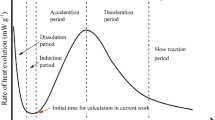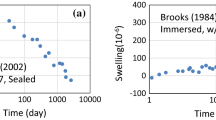Abstract
The present paper presents a detailed description of a model elaborated to predict the behavior of hydrated cement systems subjected to sub-freezing temperatures. The model was developed within the framework of poro-mechanics and accounts for local thermodynamic equilibrium between various phases. Ice formation is described at the pore scale and its effects on the thermoporo-elastic behavior of the homogenized porous medium are considered. Basic numerical considerations are formulated. A comparison with experimental results illustrates the ability of the model to predict the volume instabilities of hydrated cement pastes upon freezing.
Résumé
Les principaux aspects d'un modèle permettant de prédire le comportement au gel de matériaux cimentaires sont détaillés. Le modèle a été développé en se basant sur les concepts de la poro-mécanique et permet de prendre en considération l'équilibre thermodynamique local entre différentes phases. La formation de la glace est décrite à l'échelle du pore et ses effets sur le comportement thermo-poro-élastique du milieu poreux homogénéisé sont considérés. Des considérations numériques élémentaires sont formulées. Une comparaison avec des résultats expérimentaux illustre la capacité du modèle à prédire les instabilités volumiques de pâtes de ciment hydraté exposées à des conditions de gel.
Similar content being viewed by others
References
Powers, T.C. and Brownyard, T.L., ‘Studies of the physical properties of hardened Portland cement paste—Part 8: The freezing of water in hardened Portland cement paste’,Journal of the American Concrete Institute 18(8) (1946) 934–969.
Litvan, G.G., ‘Frost action in cement paste’,Mater. Struct. 34 (1973) 3–8.
Setzer, M.J., ‘Interaction of water with hardened cement paste’, in: S. Mindess (Ed.), ‘Advances in Cementitious Materials’,Am. Ceram. Soc. Trans. 16, Westerville, Ohio, USA, 1990, 415–439.
Powers, T.C., ‘The air requirement of frost-resistant concrete’, Proceedings of the Highway Research Board29 (1949) 184–211.
Scherer, G.W., ‘Crystallization in pores’,Cement and Concrete Research 29(8) (1999) 1347–1358.
Powers, T.C. and Helmuth, R.A., ‘Theory of volume changes in hardened Portland cement paste’, Proceedings of the Highway Research Board32 (1953) 285–297.
Feldman, R.F., ‘Length change-adsorption relations for the water-porous glass system to −40°C’,Canadian Journal of Chemistry 42(2) (1970) 287–297.
Litvan, G.G., ‘Phase transitions of adsorbates—Part IV: Mechanism of frost action in hardened cement paste’,Journal of the American Ceramic Society 55(1) (1972) 38–42.
Powers, T.C., ‘Topics in concrete technology: Part 3-Mixtures containing intentionally entrained air’,Journal of PCA Research and Development Laboratories 6(3) (1964) 19–42.
Marchand, J., Pleau, R. and Gagné, R., ‘Deterioration of concrete due to freezing and thawing’, Material Science of Concrete, Vol. 1, American Ceramic Society, Westerville, OH, USA, 283–354, 1995.
Penttala, V.E., ‘Freezing-induced strains and pressures in wet porous materials and especially in concrete mortars’,Advanced in Cement Based Materials 7 (1998) 8–19.
Bager, D.H. and Sellevold, E.J., ‘Ice formation in hardened cement paste—Part I: Room temperature cured paste with variable moisture contents’,Cement and Concrete Research 16(5) (1986) 709–720.
Fagerlund, G., ‘Moisture uptake and service life of concrete exposed to frost’, Concrete under severe conditions, Vol. 1, E & FN Spon, United-Kingdom, 1995, 221–232.
Thomas, M.D., ‘Laboratory and field studies of salt scaling in fly ash concrete’, in ‘Resistance of Concrete to Freezing and Thawing’, Edited by M.J. Setzer and R. Auberg (E & FN SPON, London, U.K., 1997) 21–30.
Marchand, J., Pigeon, M., Maltais, Y., Machabée, Y. and Talbot, C., ‘Influence of fly ash on the concrete scaling resistance’, Edited by M.J. Setzer and R. Auberg, E & FN SPON, London, U.K., 11–20, 1997.
Zuber, B., ‘Towards a model describing the volume instability of hydrated cement systems exposed to sub-freezing temperatures’, Ph.D. Thesis, Department of Civil Engineering, École Normale Supérieure de Cachan-Laval University, France-Canada, 2002 [in French].
Zuber, B. and Marchand, J., ‘Modeling the deterioration of hydrated cement systems exposed to frost action—Part 1: Description of the mathematical model’,Cement and Concrete Research 30(12) (2000) 1929–1941.
Diamond, S., ‘Cement paste microstructure: An overview at several levels’, Proceedings of the Conference on Hydraulic Cement Paste—Their Structure and Properties, Sheffield, England, British Cement and Concrete Association, 1976, 2–30.
Diamond, S. and Winslow, D.N., ‘A mercury porosimetry study of the evolution of porosity in Portland cement’,Journal of Materials 5(3) (1970) 564–585.
Sellevold, E.J. and Bager, D.H., ‘Some implications of calorimetric ice formation results for frost resistance testing of cement products’, Technical Report 86/80, The Technical University of Denmark, Building Materials Laboratory, 1985, 28 p.
Zuber, B., Marchand, J., Delagrave, A. and Bournazel, J.P., ‘Ice formation mechanisms in normal and high-performance concrete mixture’,ASCE Materials Journal 12(1) (2000) 16–23.
Coussy, O., ‘Mechanics of porous continua’ (John Wiley & Sons Ltd, 1995).
Bary, B., ‘Study of the hydro-mechanical coupling in damaged concrete’, Ph.D. Thesis, École Normale Supérieure de Cachan, Cachan, France, 1996 [in French].
Akinfiev, N.N., Mironenko, M.V. and Grant, S.A., ‘Thermodynamic properties of NaCl solutions at subzero temperatures’,Journal of Solution Chemistry 30(12) (2001) 1065–1080.
Hobbs, P.V., ‘Ice Physics’ (Clarendon Press, Oxford, UK, 1974).
Bornert, M., Bretheau, T. and Gilormini, P., ‘Homogénéisation en Mécanique des Matériaux. 1—Matériaux Aléatoires Élastiques et Milieux Périodiques’ (Hermès Science, 2001).
Happel, J. and Brenner, H., ‘Low Reynolds number hydrodynamics’, in ‘Mechanics of Fluids and Transport Processes’, 5th edition (Kluwer Academic Publishers, Dordrecht, The Netherlands, 1991).
Hassanizadeh, M. and Gray, W.G., ‘General consideration equations for multiphase system—Part 3: Constitutive theory for porous media flow’,Advances in Water Research 3 (1980) 25–40.
Defay, R., Prigogine, I., Bellemans, A. and Everett, D.H., ‘Surface Tension and Adsorption’ (Longmans, 1966).
Gregg, S.J. and Sing, K.S.W., ‘Adsorption, surface area and porosity’, 2nd edition (Academic Press, Harcourt Brace & Company Publishers, London, UK, 1982).
Drost-Hansen, W., ‘The water-ice interface as seen from the liquid side’,Journal of Colloid and Interfaces Science 25 (1967) 131–160.
Fagerlund, G., ‘Determination of pore-size distribution from freezing-point depression’,Mater. Struct. 6(33) (1973) 215–225.
Scherer, G.W., ‘Freezing gels’,Journal of Non-Crystalline Solids 155 (1993) 1–25.
Schulson, E.M., ‘The structure and mechanical behavior of ice’,JOM: Member Journal of The Minerals, Metals & Materials Society 51(2) (1999) 21–27.
Anatoly, M.F. and Zaretsky, Y.K., ‘Ice strength as a function of hydrostatic pressure and temperature’, CRREL, Report 97-6, 1997.
Reddy, J.N., ‘An introduction to the finite element method, 2nd edition (McGraw Hill, New York, USA, 1993).
Schrefler, B.A., Sanavia, L. and Majorana, C.E., ‘A multiphase medium model for localisation and postlocalisation simulation in geomaterials’,Mechanics of Cohesive-Frictional Materials 1 (1996) 95–114.
Dureisseix, D., ‘Towards efficient computational strategies for multiphysics problems—Using the multiscale features’, Habilitation à diriger les recherches, Université Pierre et Marie Curie Paris 6, France, 2001 [in French].
Lallement, J.-M., ‘Study of the change in the physical properties of a saturated porous medium exposed to freezing’, DEA Thesis, École Normale Supérieure de Cachan, Cachan, France, 2000 [in French].
ASTM Standard Test—C 457, ‘Standard test method for microscopical determination of parameters of the air-void system in hardened concrete’, Annual Book of ASTM Standards, Vol. 04.02, 1992.
Snyder, K.A., ‘A numerical test of air void spacing equations’,Advanced Cement Based Materials 3 (1998) 28–44.
Setzer, M.J., ‘A new approach to describe frost action in hardened cement paste and concrete’, Proceedings of the Conference on Hydraulic cement pastes—Their structures and properties, British Cement and Concrete Association, Sheffield, England, UK, 1976, 312–325.
Feldman, R.F. and Beaudoin, J.J., ‘Pretreatment of hardened hydrated cement pastes for mercury intrusion measurements’,Cement and Concrete Research 21 (1991) 297–308.
Gallé, C., ‘Effect of drying on cement-based materials pore structure as identified by mercury intrusion porosimetry—A comparative study between oven-, vacuum-, and freeze-drying’,Cement and Concrete Research 31(2) (2001) 1467–1477.
Feldman, R.F. and Beaudoin, J.J., ‘Microstructure and strength of hydrated cement’,Cement and Concrete Research 6 (1976) 389–400.
Grant, S.A., ‘Physical and chemical factors affecting contaminant hydrology in cold environments’, ERDC/CRREL, Technical Report TR-00-21, 2000.
Author information
Authors and Affiliations
Additional information
Editorial Note Laval University (Canada) is a RILEM Titular Member. Prof. Jacques Marchand is Editor in Chief forConcrete Science and Engineering and Associate Editor forMaterials and Strutures, as well as a member of the RILEM Management Advisory Committee (MAC). He was awarded the 2000 Robert L'Hermite Medal. He also participates in the work of RILEM TC 195-DTD ‘Recommendation for test methods for autogenous deformation and thermal dilation of early age concrete’.
Rights and permissions
About this article
Cite this article
Zuber, B., Marchand, J. Predicting the volume instability of hydrated cement systems upon freezing using poro-mechanics and local phase equilibria. Mat. Struct. 37, 257–270 (2004). https://doi.org/10.1007/BF02480634
Received:
Accepted:
Issue Date:
DOI: https://doi.org/10.1007/BF02480634




